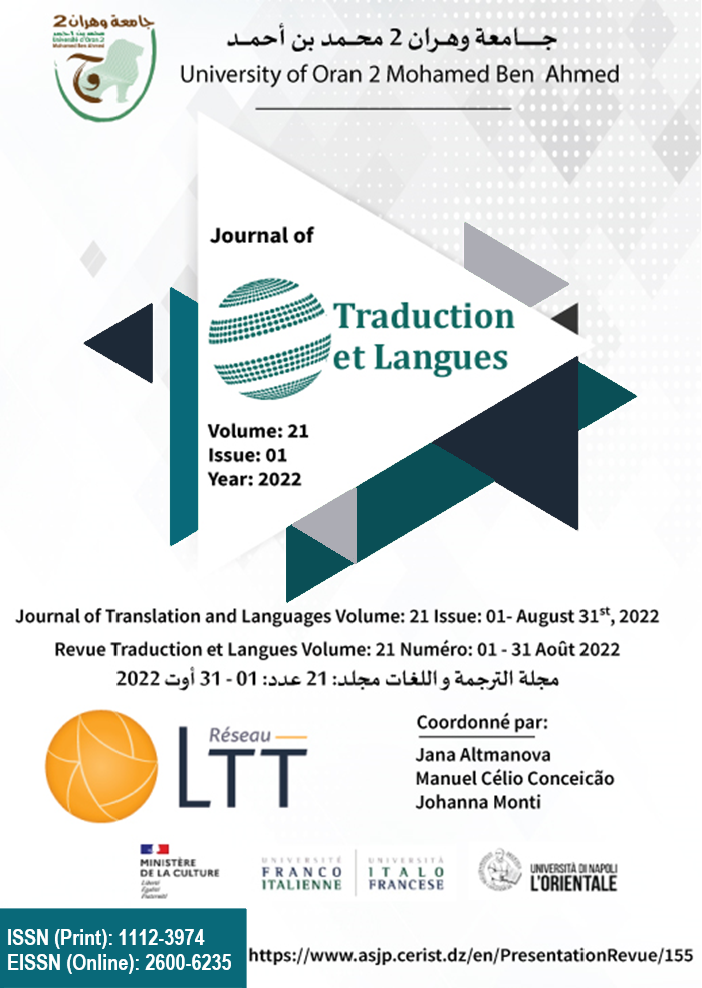Une Approche Linguistique pour l’Analyse, la Reconnaissance et la Traduction Automatiques des Verbes du Domaine Administratif et de Droit
Main Article Content
Abstract
A Linguistic Approach to The Analysis, Recognition and Automatic Translation of Administrative and Legal Verbs
Due to globalization and with the advent of the new digital era, economic, social, and mostly administrative sectors are now required to participate in the digitization and automation of data. This will make several tasks that were previously totally performed by humans easier. Hence, in this context, the present study investigated the application of machine translation (MT) in the administrative field. Using a semantic-syntactic approach and the French Verbs (LVF) dictionary by Jean Dubois and Françoise Dubois-Charlier, we analyzed the verbs used in the administration and legal fields. Following this initial theoretical stage, and using the NooJ platform, we deployed the acquired linguistic data for the construction of a French-Arabic machine translation application. To implement this application, we will design formal grammars for the automatic analysis and recognition of the many semantic-syntactic schemes defining this class of verbs, as well as a bilingual dictionary of legal and administrative verbs. The utmost objective of this research work is the achievement of an accurate and trustworthy translation. In the first theoretical part, we will identify the linguistic characteristics of the different verbs in the administrative and legal fields. At this first level of our approach, we will examine the syntactic constructions of these verbs and then, we will try to delimit the patterns or the distinctive semantic-syntactic schemes of the verbs used in a very specific discourse, which is the administrative discourse. In the second stage of automatic processing, we will try to create a computer process which can:
• Automatically analyze and recognize administrative verbs using the NooJ
platform.
• Properly translate the verbs studied in Arabic.
For the creation of this MT process, the interest of which mainly concerns
administrative documents, for social (divorce, inheritance, etc.) and even
economic reasons, we will:
a/ Integrate legal and administrative verbs into a bilingual French-Arabic
electronic dictionary, describing them according to NooJ operators: inflection,
conjugation, derivation and syntax operators, etc. In this step, we created:
• Paraderivational.nof derivational paradigms.
• “paraflexion.nof” bending paradigms.
• “paradigmflexionnel.nof” conjugation paradigms
• The syntactic formalization where we rewrote the syntactic schemes of the LVF.
• The translation of each verbal entry into Arabic.
Exp :
V+Emploi=01+AUX=AVOIR+FLX=CHANTER+CONS=T11b0+N0VN1PREP
N2+N0Hum+V+N1Hum+N2Abst+N2Vinf+PREP="de"+DRV=AV1e : ARTISTE
+DRV=AV2: COUSIN+DRV=DN15: DIRECTOR+DRV=DN15a:
TABLE+DOM=DRO
+CLASS=F2c+OPER="ict qn D offence"+LEXI=1+AR="َََّتَهَم
b/ Schematize the semantic-syntactic patterns by the formal grammars of NooJ, to automatically recognize the legal verbs used in an administrative corpus. The formal grammars used are called syntactic disambiguation grammars (Silberztein, Max 2015). In this phase, we produced disambiguation grammars that allowed us to analyze only the requested syntactic constructions. The disambiguation grammar is necessary and important, not only for the automatic analysis and recognition of the correct syntactic constructions, but also for producing a correct and reliable translation. c/ Create an automatic translation grammar that will allow us to obtain a suitable, reliable translation, which will respect the standards of the target language: Arabic. d/ Find solutions for the disambiguation of polysemic predicates using Gaston Gross's "object class" theory which allowed us to refine the recognition grammars and subsequently obtain encouraging results, where the verbs polysemous are suitably translated into Arabic. The originality of this study emanates from the fact that it provides, not only a linguistic description of the verbs of the administrative and legal domain, but especially of the integration of the various data in the NooJ software, in order to facilitate the treatment and the automatic translations of the two languages in question.
